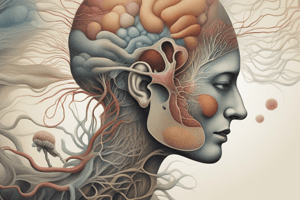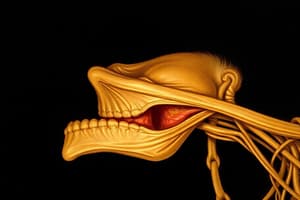Podcast
Questions and Answers
Which cranial nerve is responsible for conveying information about blood pressure through its primary sensory ganglion?
Which cranial nerve is responsible for conveying information about blood pressure through its primary sensory ganglion?
- Facial nerve
- Hypoglossal nerve
- Glossopharyngeal nerve (correct)
- Optic nerve
Which of the following cranial nerves is associated with the viscero-sensory functions?
Which of the following cranial nerves is associated with the viscero-sensory functions?
- Trigeminal nerve
- Olfactory nerve
- Accessory nerve
- Vagus nerve (correct)
What is the correct relationship between the sympathetic innervation and cranial nerves regarding the head?
What is the correct relationship between the sympathetic innervation and cranial nerves regarding the head?
- All sympathetic innervation to the head originates from the glossopharyngeal nerve.
- Cranial nerves supply all sympathetic innervation to the head.
- Sympathetic innervation to the head comes solely from the vagus nerve.
- There is no sympathetic supply from the cranial nerves. (correct)
Which spinal cord segments contribute to sympathetic innervation to the head?
Which spinal cord segments contribute to sympathetic innervation to the head?
The primary sensory ganglion for the glossopharyngeal nerve is involved in which function?
The primary sensory ganglion for the glossopharyngeal nerve is involved in which function?
Which of the following sensory faculties is not classified as a special sensory function?
Which of the following sensory faculties is not classified as a special sensory function?
Which cranial nerve is primarily involved in special sensory functions, particularly taste?
Which cranial nerve is primarily involved in special sensory functions, particularly taste?
How does sympathetic innervation reach the head region from the spinal cord?
How does sympathetic innervation reach the head region from the spinal cord?
Which function is primarily associated with the viscero-motor component of cranial nerves?
Which function is primarily associated with the viscero-motor component of cranial nerves?
Which cranial nerve is the only one that enters and exits the skull?
Which cranial nerve is the only one that enters and exits the skull?
What is proptosis, and what condition can cause it?
What is proptosis, and what condition can cause it?
What causes ptois and diplopia, as mentioned in the conditions associated with cranial nerves?
What causes ptois and diplopia, as mentioned in the conditions associated with cranial nerves?
Which type of eye movement is primarily controlled by the frontal lobe?
Which type of eye movement is primarily controlled by the frontal lobe?
Which cranial nerve is likely to be affected first by a sudden aneurysm?
Which cranial nerve is likely to be affected first by a sudden aneurysm?
What is the main function of the spinal accessory nerve?
What is the main function of the spinal accessory nerve?
What condition is associated with chemosis?
What condition is associated with chemosis?
Which of the following cranial nerves is NOT typically involved in eye movement disorders?
Which of the following cranial nerves is NOT typically involved in eye movement disorders?
What is the primary role of the cavernous sinus in relation to cranial nerves?
What is the primary role of the cavernous sinus in relation to cranial nerves?
What is a common symptom of ophthalmoplegia?
What is a common symptom of ophthalmoplegia?
What is primarily analyzed by the cochlea?
What is primarily analyzed by the cochlea?
Which area of the brain is primarily associated with speech integration?
Which area of the brain is primarily associated with speech integration?
What kind of messages do the vestibular apparatus and semicircular canals send?
What kind of messages do the vestibular apparatus and semicircular canals send?
Which cranial nerve is associated with the vestibular ganglia?
Which cranial nerve is associated with the vestibular ganglia?
The semicircular canals have receptors that respond to what type of acceleration?
The semicircular canals have receptors that respond to what type of acceleration?
What is the primary function of the Associative Auditory Cortex?
What is the primary function of the Associative Auditory Cortex?
Which muscle is responsible for eyelid elevation, as mentioned in relation to the oculomotor nerve?
Which muscle is responsible for eyelid elevation, as mentioned in relation to the oculomotor nerve?
Which part of the brain is specifically associated with processing music?
Which part of the brain is specifically associated with processing music?
What type of neurons makes up the cell bodies in the vestibular nuclei?
What type of neurons makes up the cell bodies in the vestibular nuclei?
Adduction, an important motor action of which cranial nerve, is primarily related to moving the eyeball?
Adduction, an important motor action of which cranial nerve, is primarily related to moving the eyeball?
Which nerve primarily provides sensation to the upper teeth?
Which nerve primarily provides sensation to the upper teeth?
What structure does the maxillary nerve (CN V2) exit through?
What structure does the maxillary nerve (CN V2) exit through?
Which nerve is responsible for sensation in the skin of the cheekbone?
Which nerve is responsible for sensation in the skin of the cheekbone?
Which nerve carries sensory fibers to the nasopharynx and posterior part of the nasal cavity?
Which nerve carries sensory fibers to the nasopharynx and posterior part of the nasal cavity?
Which of the following nerves does NOT contain sensory fibers?
Which of the following nerves does NOT contain sensory fibers?
The infra-orbital nerve provides sensation to which of the following areas?
The infra-orbital nerve provides sensation to which of the following areas?
Which nerve enters the orbital cavity through the superior orbital fissure?
Which nerve enters the orbital cavity through the superior orbital fissure?
Which of the following does NOT belong to the branches of the maxillary nerve (CN V2)?
Which of the following does NOT belong to the branches of the maxillary nerve (CN V2)?
Which nerve provides sensory supply to the lateral side of the forehead?
Which nerve provides sensory supply to the lateral side of the forehead?
What is a function of the lacrimal nerve?
What is a function of the lacrimal nerve?
What is the main function of the chorda tympanic nerve?
What is the main function of the chorda tympanic nerve?
Which nerve is responsible for supplying the lacrimal gland?
Which nerve is responsible for supplying the lacrimal gland?
Which muscle is NOT supplied by the facial nerve?
Which muscle is NOT supplied by the facial nerve?
What structure does the greater petrosal nerve pass through to reach its target?
What structure does the greater petrosal nerve pass through to reach its target?
Which branch of the facial nerve primarily supplies the muscles of facial expression?
Which branch of the facial nerve primarily supplies the muscles of facial expression?
The posterior auricular nerve is responsible for innervating which of the following?
The posterior auricular nerve is responsible for innervating which of the following?
Flashcards are hidden until you start studying
Study Notes
Cranial Nerves Overview
- Viscero-motor and viscerosensory functions are critical components of cranial nerve organization.
- Special senses include smell, sight, taste, hearing, and balance.
Sympathetic Innervation
- Sympathetic supply to the head originates from the lateral horn of spinal cord segments C8 - T5.
- Innervation travels via the superior cervical ganglion along the internal carotid artery.
- No sympathetic fibers are carried by cranial nerves.
Viscero-sensory Information
- Glossopharyngeal nerve (IX) ganglion detects blood pressure.
- Vagus nerve (X) ganglion contributes to visceral sensory functions.
Cranial Nerve VIII: Vestibular Nerve
- Vestibular ganglia contain cell bodies of bipolar neurons essential for balance and equilibrium.
- Five sensory organs include three cristae in semicircular canals responding to rotation.
Cochlea and Auditory Processing
- Afferent impulses from the cochlea are linked to hearing.
- Associative auditory cortex compares sounds to past experiences.
- Speech processing occurs predominantly in the left hemisphere (Wernicke’s and Broca’s areas).
- Music processing is centered in the right temporal lobe.
Oculomotor Nerve (CN III)
- Responsible for all eye movements, with adduction being the primary action.
- Elevates the eyelid via levator palpebrae superioris muscle.
Cranial Nerve Pathways
- Cranial Nerve XI (Spinal Accessory) enters and exits the skull, innervating sternocleidomastoid and trapezius muscles.
- Dysfunction can lead to ptosis, diplopia, and ophthalmoplegia due to cavernous sinus pathology.
Clinical Considerations
- Sudden aneurysm development may first affect the abducens nerve (CN VI).
Types of Eye Movements
- Saccadic movements are rapid shifts from one fixation to another, controlled by the frontal lobe.
Maxillary Nerve (CN V2)
- Exclusively sensory fibers, exits through foramen rotundum.
- Branches include greater and lesser palatine nerves, superior alveolar nerve, infra-orbital nerve, and zygomatic nerve.
Ophthalmic Nerve (CN V1)
- Contains purely sensory nerve fibers and exits through the superior orbital fissure.
- Lacrimal nerve provides sensory innervation to the tear duct, eye sclera, cornea, and upper eyelid.
Facial Nerve Functions
- Greater petrosal nerve supplies the lacrimal gland and mucosa of the nose, sinuses, and upper mouth.
- Chorda tympanic nerve provides parasympathetic fibers to the submandibular and sublingual glands, along with taste sensations from 2/3 of the tongue.
- Stylohyoid muscle and posterior belly of the digastric muscle are supplied through the stylomastoid foramen.
Expression and Functionality
- Muscles of facial expression are innervated by the facial nerve and are crucial for non-verbal communication.
Studying That Suits You
Use AI to generate personalized quizzes and flashcards to suit your learning preferences.




